
Art Therapy
“One of the basic rules of the universe is that nothing is perfect. Perfection simply doesn’t exist…..Without imperfection, neither you nor I would exist” ― Stephen Hawking



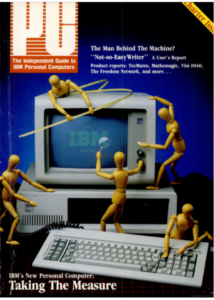
We were sitting in the car at the parking lot of the drug store, waiting for the results of our COVID-19 rapid test. Not wanting to stay inside, and escaping from the heat, we had the air conditioning on and listened to the radio. The announcer commented that today, August 12, 40 years ago, IBM released the IBM Personal Computer 5150. This was the first IBM “PC” and the announcer claimed that it became the basis for all PCs today. The speed with which the PC made its mark was reflected in 1982 when Time Magazine broke with style and chose the personal computer as its “Man of the Year.” In the radio interview 40 years ago, the IBM rep predicted that within 50 years every household would have a computer.
In 1977, three new pre-assembled small computers hit the markets which Byte magazine referred to as the “1977 Trinity” of personal computing. The Apple II and the PET 2001 were advertised as personal computers, while the TRS-80 was described as a microcomputer used for household tasks including “personal financial management.” By 1979, over half a million microcomputers were sold and “the youth of the day had a new concept of the personal computer.”
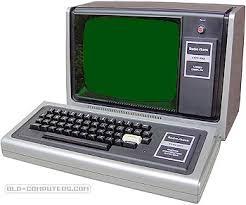 We were probably among the first household to own a computer. My husband chose the TRS-80 (TRS stood for “Tandy Radio Shack” and the “80″ referenced the microprocessor, the Z-80). It was announced at a press conference in August, with the first orders shipped in September, 1977. We were among the first customers. In several days over 15,000 people called Radio Shack to purchase a TRS-80, paralyzing their switchboard. Still forecasting 3,000 sales a year, the company sold over 10,000 TRS-80 Model I computers in its first one and a half months of sales, and over 200,000 during the product’s lifetime. The Model I went on to become the best-selling microcomputer for several years, and it had the largest available selection of software in the microcomputer market – the operating system was ROM-based, and included BASIC.
We were probably among the first household to own a computer. My husband chose the TRS-80 (TRS stood for “Tandy Radio Shack” and the “80″ referenced the microprocessor, the Z-80). It was announced at a press conference in August, with the first orders shipped in September, 1977. We were among the first customers. In several days over 15,000 people called Radio Shack to purchase a TRS-80, paralyzing their switchboard. Still forecasting 3,000 sales a year, the company sold over 10,000 TRS-80 Model I computers in its first one and a half months of sales, and over 200,000 during the product’s lifetime. The Model I went on to become the best-selling microcomputer for several years, and it had the largest available selection of software in the microcomputer market – the operating system was ROM-based, and included BASIC.
It was a great addition to the many electronic devices in our home, and my husband, who worked with mainframe computers for many years already proceeded to experiment with programming the machine. One day our 9-year-old had a friend over, and we heard swearing coming from the basement room where they played. When we came in to see what was going on, they were laughing. It was not they who swore, but the computer! They used the speech synthesis device, which my husband had bought, to teach the computer swear words, and the computer dutifully followed their instructions. I guess boys will always be boys.
The next wonder to come to my possession was the first laptop I ever owned. It was the TRS-80 Model 100, a portable computer introduced in 1983. It was one of the first notebook-style computers, featuring a keyboard and liquid crystal display, in a battery-powered package roughly the size and shape of a notepad or large book. It became one of the company’s most popular models, with over 6 million units sold worldwide. It had a keyboard built in and a display screen on which you could see 8 lines of text at a time. The portability and simplicity of the Model 100 made it attractive to journalists, who could type about 11 pages of text and then transmit it for electronic editing and production using the built-in modem and TELECOM program.
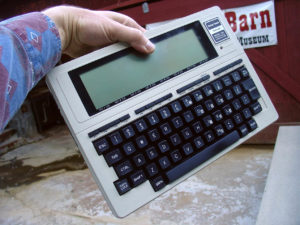 I carried with pride my new wonder to many conferences and meetings, and was able to type notes right there and then, without the need to record, or to use pen and paper for later transcription. People were awed and looked at me as a real innovator. I must say I actually enjoyed the reputation. It was not much later that I was asked to be the writer of the computer column for the newsletter of the Association of College Unions International. What a laugh! I did not know much about computers, but since my husband used to buy a few computer magazines, and since my husband and I discussed different projects that might be interesting for the members of the association, I managed to do a fairly decent job of it. Reading the magazines also benefited me by providing information which I found useful for my work.
I carried with pride my new wonder to many conferences and meetings, and was able to type notes right there and then, without the need to record, or to use pen and paper for later transcription. People were awed and looked at me as a real innovator. I must say I actually enjoyed the reputation. It was not much later that I was asked to be the writer of the computer column for the newsletter of the Association of College Unions International. What a laugh! I did not know much about computers, but since my husband used to buy a few computer magazines, and since my husband and I discussed different projects that might be interesting for the members of the association, I managed to do a fairly decent job of it. Reading the magazines also benefited me by providing information which I found useful for my work.
I became the manager of the Art-Craft Studio at the University of Western Ontario in the fall of 1979. The studio was my pride and joy. Besides great facilities for woodworking, pottery, photography, and more for the university community to use, it also featured an art-supply store. Every month we had to close the place for 2 days in order to count inventory. I employed 8 students who worked in shifts, and all of us hated the task of counting inventory. Cash registers with inventory control were just getting into the market, but there was no way the university would approve the purchase of one, at a cost of $30,000. In one of my husband’s magazines, I found an ad for a Cash-Register Expansion System. The CR-180 was a cash register/point-of-sale expansion system for the TRS-80 Model III. The CR-180 expansion system was supplied with an electronic cash drawer and a receipt printer which plugged directly into the TRS-80 Model III. The system cost was only $150! However, we needed to buy the TRS-80 III computer as well, and to adjust the program to fit our needs. 
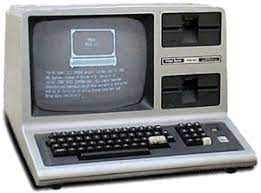 It was not difficult to fit $150 into my budget, so I bought the CR-180. The question was how to adapt it to our needs. I believe in team management, so all the students who worked in the studio were part of the think tank to decide what our needs were and how best to go about adapting the system to perform to our satisfaction. It was an era in which technology innovations were not always welcomed by the workers, therefore I was adamant in involving the team in decision making, so that they would be invested in the process. One of the workers was a student in computer science and she was happy to write the inventory program to go with the equipment I bought. We did not have the computer to try it on, so I convinced the local TRS-80 dealer to let us use one of their machines, with the idea that if everything worked, we would buy it. The university administration agreed to the deal, and the work began. It took longer than we imagined, as all computer-software projects usually do, but after 4 months we were able to buy the machine, install it, and then input all the inventory. We were all so enthusiastic, it seemed like a game – and it worked! We even had a place to input frame measurements and presto, the cost of the frame and glass were calculated and ready for payment. How proud we were! And how innovative! We practically produced a point-of-sale system fitted exactly to our needs for less than $2,500 when the available commercial system cost over $30,000!
It was not difficult to fit $150 into my budget, so I bought the CR-180. The question was how to adapt it to our needs. I believe in team management, so all the students who worked in the studio were part of the think tank to decide what our needs were and how best to go about adapting the system to perform to our satisfaction. It was an era in which technology innovations were not always welcomed by the workers, therefore I was adamant in involving the team in decision making, so that they would be invested in the process. One of the workers was a student in computer science and she was happy to write the inventory program to go with the equipment I bought. We did not have the computer to try it on, so I convinced the local TRS-80 dealer to let us use one of their machines, with the idea that if everything worked, we would buy it. The university administration agreed to the deal, and the work began. It took longer than we imagined, as all computer-software projects usually do, but after 4 months we were able to buy the machine, install it, and then input all the inventory. We were all so enthusiastic, it seemed like a game – and it worked! We even had a place to input frame measurements and presto, the cost of the frame and glass were calculated and ready for payment. How proud we were! And how innovative! We practically produced a point-of-sale system fitted exactly to our needs for less than $2,500 when the available commercial system cost over $30,000!
As always, problems crop up. Do any of you remember floppy disks? Those are the 5 ¼-inch magnetic diskettes we used for storing data. Before turning off the computer for the night, the person closing the Studio had to back up all the day’s sales activities onto a floppy storage disk. In order to make sure that data was not lost, there always had to be a disk with data from the previous day available in case something happened and the system crashed, so we would not have to input all the data again, and lose the advantage of the point-of-sale inventory count. The question was how many disks did we need to have? We discussed it as a team, and I came up with the idea of having only 2 diskettes – one for even days and one for odd days. My team looked at me with blank faces. What on earth are odd and even days? I started laughing. I realized then and there the cultural biases we all have. Even though I was at that point already living in English almost 20 years, I still thought of the days of the week by their Hebrew names, which are “first day”, second day, and so on until the seventh which is Shabbat. So odd and even was a natural deduction from the names. At the end, it was less confusing to have one diskette for each day of the week. Sunday, Monday, Tuesday, etc. One only needed to remember what day of the week it was, and sometimes, ….
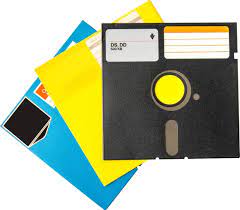 Today most households have at least one if not 2 computers, a tablet, a laptop, and one for the road, called a cell phone. It has all the functions of the monsters of the 70s at your fingertips, and more. The young generation has it attached to their person 24 hours of the day. It has apps for anything your heart desires and more. Thinner and lighter, with better cameras and storage, they replace sometimes even the cash register with their credit-card readers. PC is a thing of the past. Who thought it possible 40 years ago? Some dreams do come true; we may need to be careful what we wish for or dream.
Today most households have at least one if not 2 computers, a tablet, a laptop, and one for the road, called a cell phone. It has all the functions of the monsters of the 70s at your fingertips, and more. The young generation has it attached to their person 24 hours of the day. It has apps for anything your heart desires and more. Thinner and lighter, with better cameras and storage, they replace sometimes even the cash register with their credit-card readers. PC is a thing of the past. Who thought it possible 40 years ago? Some dreams do come true; we may need to be careful what we wish for or dream.